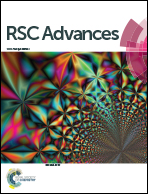Electrochemical preparation and characterization of a polypyrrole/nickel-cobalt hexacyanoferrate nanocomposite for supercapacitor applications
Abstract
A polypyrrole/nickel-cobalt hexacyanoferrate (PPy/NiCoHCF) nanocomposite is synthesized using a fast and facile electrochemical approach on a low cost stainless steel substrate. The prepared nanocomposite is characterized in terms of composition and morphology using X-ray diffraction spectroscopy, energy dispersive X-ray spectroscopy, FT-IR spectroscopy and scanning electron microscopy. The capacitive behavior of the nanocomposite is investigated by means of cyclic voltammetry, galvanostatic charge/discharge technique and electrochemical impedance spectroscopy, in an aqueous electrolyte of 0.5 mol L−1 K2SO4 and in a non-aqueous electrolyte of 0.5 mol L−1 LiClO4/ethylene carbonate:dimethyl carbonate (EC:DMC). The results showed that incorporation of NiCoHCF with PPy improves the capacitance properties of PPy in both aqueous and non-aqueous media. Maximum capacitances of 529 F g−1 and 668 F g−1 at the current density of 1.0 A g−1 are achieved for the proposed nanocomposite in aqueous and non-aqueous electrolytes, respectively, using galvanostatic charge–discharge technique. Moreover, the nanocomposite showed an excellent stability (less than 10% drop after 1000 cycles), high specific power density (5600 W kg−1) and high specific energy density (87 W h kg−1) at a current density of 10 A g−1. Based on the obtained results, the proposed nanocomposite is a potential candidate as an electrode material in electrochemical supercapacitors.


 Please wait while we load your content...
Please wait while we load your content...